Punica granatum
Can you imagine being the first person to stumble upon a pomegranate growing in the wild? What must they have thought, when they found those odd globes hanging from the branches just overhead?
When I think about all of the history that has come before us, especially in the botanical world, my imagination runs wild!
I can’t help but think of those who came before us, spotting a curious new plant, and bringing it home to their family or colleagues to ponder over it.
Maybe it would be delicious. Or maybe it would prove deadly.
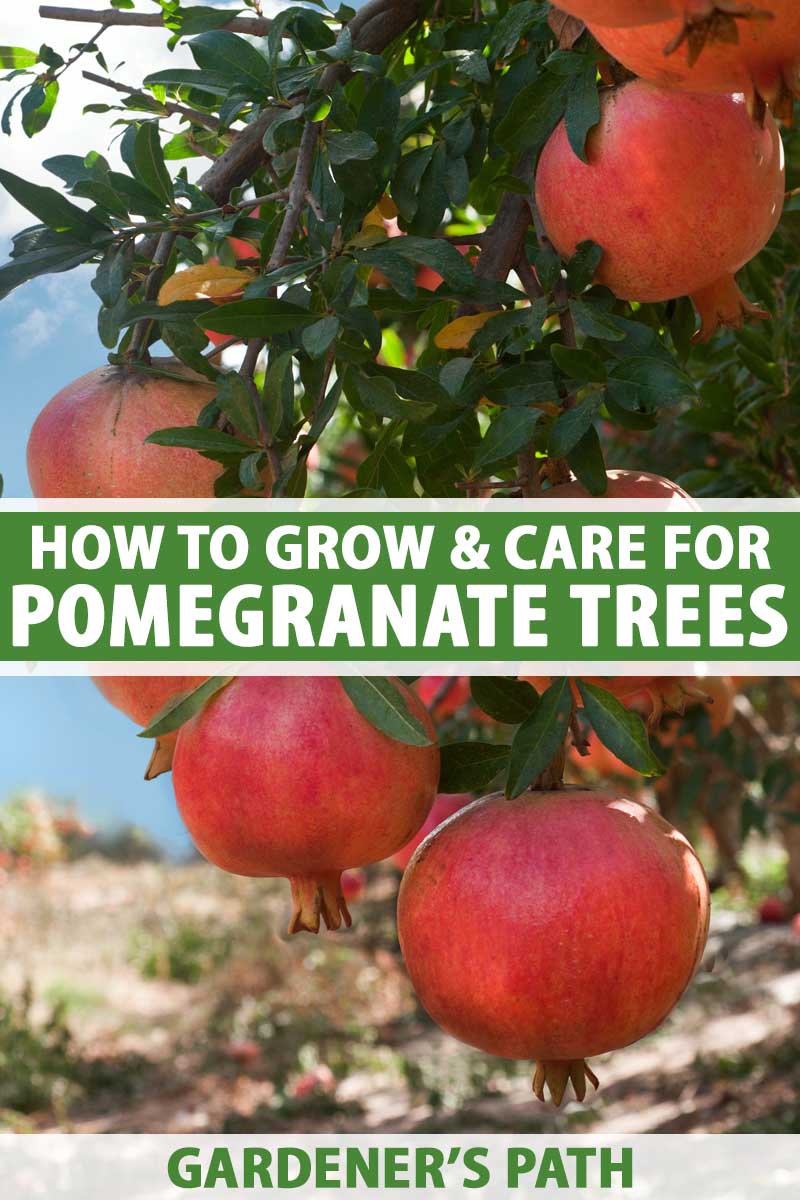
We link to vendors to help you find relevant products. If you buy from one of our links, we may earn a commission.
I know I would’ve been eager to figure out what lay inside of it! How fortunate that our forebears sampled this once-wild fruit, with its one-of-a-kind shape, and its inner chambers bursting with nutritious, juicy gems.
That discovery has led to thousands of years of cultivation, with the pomegranate making the rounds from one continent to another as growing numbers of gardeners, orchardists, and hungry people discovered its beauty and its unique flavor.
In this guide, we’ll cover how to grow and care for your own pomegranates. Here’s what’s ahead:
What You’ll Learn
Before you plant those seeds or purchase plants, it’s helpful to take some time to learn about where pomegranates come from and what conditions are ideal for their health, growth, and productivity.
What Is Pomegranate?
In 1725, the species was named Punica granatum by Carl Linnaeus, the Swedish “father of taxonomy,” which translates to “many-seeded apple” or “grainy apple.”
The list of common names for the fruit includes seeded apple, the apple of Grenada, and the French pomme-grenade, which is where the modern name may be derived from in English.
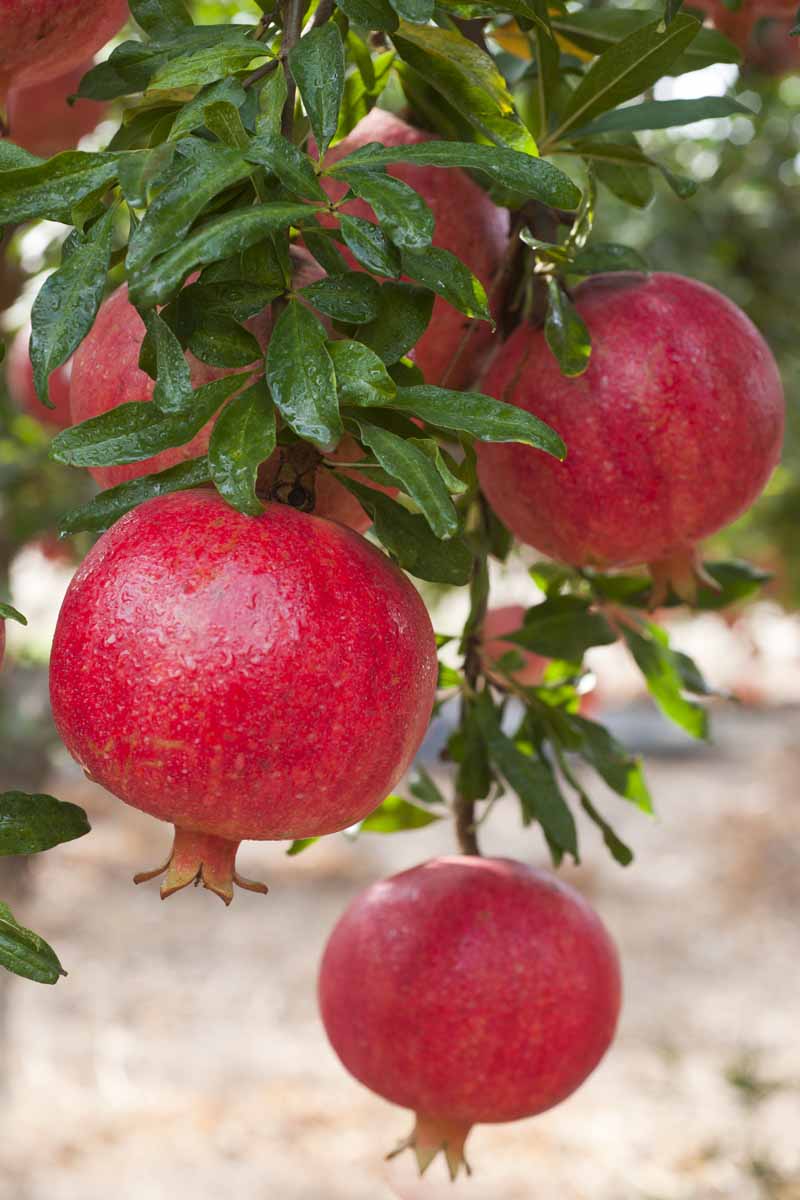
Pomegranates may be either deciduous or evergreen, depending on regional temperatures. While this species has a naturally shrublike habit, it’s commonly pruned into a tree form.
The leaves are oblong and lance-shaped, smooth, and glossy. They’re typically two to three inches long.
The foliage is interspersed with spines, or thorns, and as the tree matures, some of them can be nearly two inches long and quite sharp.
Plants may be fruiting or ornamental, with attractive red, pink, or orange flowers.
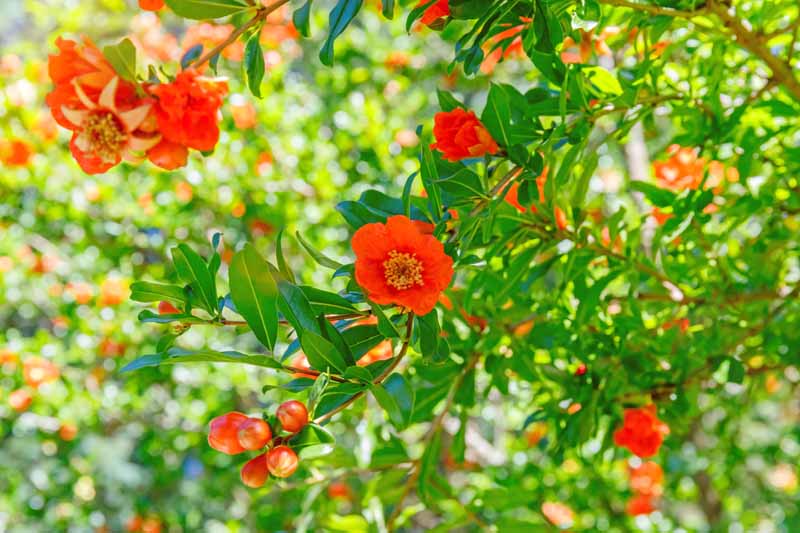
The fruits, though named after apples, are classified as berries and unrelated to pomes.
Instead, these plants belong to the myrtle order, along with many other popular garden plants including fuchsia, crepe myrtle, bottlebrush, evening primrose, and eucalyptus.
Each seed inside the tough exterior, or pericarp, is surrounded by firm flesh. These are known as arils.
The seeds can be used to propagate new plants, but will not typically grow true to the parent plant, so other methods are usually preferred.
If you’re interested in giving this method a try, we cover it in a separate guide.
Best grown for fruit production in dry and hot regions with summer daytime temperatures in the 70 to 90°F range, pomegranates are suitable for growing in USDA Hardiness Zones 7 to 11.
They aren’t generally cold hardy, though you will find a few cultivars that fit the bill, and may be damaged or killed if they’re exposed to frost and temperatures below about 20°F.
Cultivation and History
The wild pomegranate originated in the Middle East, and is native to Persia, or modern-day Iran. The history of this fruit is long and fascinating.
Let’s hit a few of the highlights.
Evidence of pomegranate cultivation exists preceding recorded history, in Bronze-Age excavations from as long ago as 3,000 BCE found in Iran and the Himalayan Mountain region.
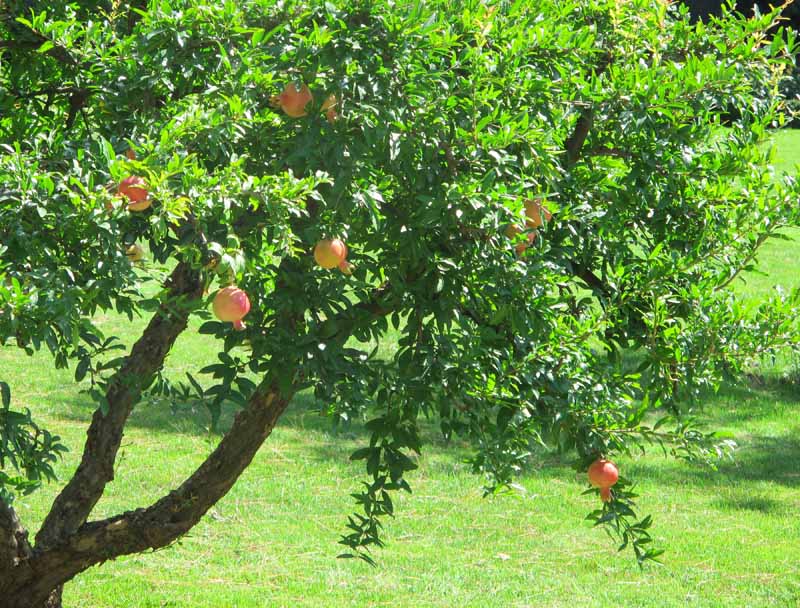
Artwork has survived from numerous ancient civilizations depicting the fruit as an important part of the cuisine and culture of ancient Persia, Rome, Greece, Egypt, and China. In many places, such as India, it was considered the food of royalty, or at the very least, a luxury item.
The pharaohs of Egypt believed the pomegranate was so important that they commissioned illustrations of the fruit to serve as evidence of their royal status, such as in hieroglyphic paintings on the interior of pyramids and fine pottery, which they believed would accompany them into the afterlife.
Images of the fruit were also minted on coins, featured on religious garb, and exhibited in temple paintings and carvings by artists across several cultures, including the Jewish people who lived in Jerusalem in biblical times.
Ancient Greeks and Romans also regarded the evergreen leaves as a symbol of strength and eternal life, and as is common of fruit containing many seeds, as a symbol of fertility.
In Greek myth, when Persephone is abducted by Hades, the fruit features as a symbol of life and regeneration, as well as marriage. You’ll see this symbolic trend repeated in other cultures, such as that of the Bedouins.
Persian myth grants the pomegranate powers that are a bit more magical in nature, such as when Isfandiyar is granted the gift of invisibility after eating a fruit.
Some even believe it to be the fruit of the tree of life in the book of Genesis in the Bible. And the pomegranate is one of the fruits that grows in the heavenly gardens of the Koran.
Dig a little deeper, and you’ll see these stories go on and on, through time and space, creating a rich tapestry.
Also known symbolically for its duality, this is a quality highlighted by its use in traditional medicine as an astringent and laxative, expectorant and antiemetic, and restorative and soporific, to name a few applications.
Medieval doctors who prescribed cure based on the four humors regarded it as warm and moist, good for alleviating coughs, or for use as an aphrodisiac.
Brought to Sicily and southern Spain with Muslim conquerors, its popularity spread.
Pomegranates were introduced to the United States by way of Spanish conquistadors and traders in the mid-1700s, and over time, came to be cultivated in regions with a hot, arid climate throughout North, Central, and South America, such as parts of modern-day California and Arizona.
In the United States, they’ve waxed and waned in popularity over the last two centuries, however, with the findings of several studies conducted within the past 20 years showing the immense nutritional value of the seeds and juice, pomegranates have become more of a mainstream food.
They’re high in fiber and folic acid, as well as vitamins C and K.
With vibrantly colored skins and blossoms used historically in dye-making and to create pigments for ancient cosmetics, the culinary use of the arils and dried seeds continues to this day in a variety of spices, juices, syrups, and liqueurs.
Grenadine is flavored with pomegranate, and the fruit can also be used to make molasses.
The leaves and flowers are also sometimes used to make tea, either dried or fresh.
Pomegranate Propagation
Like the majority of fruit trees, it’s not best to grow pomegranates from seed if the desired result is a clone of the parent plant.
Other methods, such as taking cuttings or air layering from a mature plant, will produce true clones of the parent. This means both the fruit and the growth habit of the tree or shrub will be identical to the plant you wish to replicate.
There are several possible methods to employ, and you can find comprehensive information about each of the best options for home growers in our guide to propagating pomegranates.
The easiest way to get started with growing your own pomegranates is to purchase a plant from your local garden center or online. We’ll provide some suggestions below.
These are available as potted saplings, or bare root plants.
To transplant, dig a hole that’s twice as wide and the same depth as the root ball.
If you have purchased a bare root plant, soak the roots in a bucket of water for about half an hour prior to planting.
Remove the sapling from the container, tease out the roots with your fingers, and position it into the center of the hole. Backfill with soil, tamping down gently to remove air pockets, and water in well.
Apply a layer of mulch around the new transplant, keeping it one to two inches away from the stem.
Keep the soil evenly moist while the plant is becoming established.
How to Grow Pomegranate Trees
The spot you choose for your tree should offer around eight hours of full sun per day.
The soil at the site should be loamy, or a mix of loam and sand, with a pH of 5.5 to 7.0. You may wish to conduct a soil test so you can plan to amend based on any deficiencies.
Good drainage is also a must – pomegranates are known for growing best in more arid regions, and soggy soil is a sure way to invite harmful fungal pathogens, and damage the health of your plant.

For the first year after transplanting, plan to water one to two times weekly depending on the amount of rainfall you receive.
If you’re in an area where rainfall through all or most of the year is scarce, you should plan to offer about one inch of water per week. You can use a rain gauge to measure rainfall. Mature plants are drought tolerant.
If seasonal low temperatures in your area drop below about 20°F, you’ll need to have a plan for winterizing, or plant a variety that can be grown in a container so it can be moved to a warmer, more sheltered area throughout the colder months.
It’s also helpful to know that these plants are monoecious, meaning they are self-pollinating. They produce both male and male-female blossoms, called “perfect” blossoms.
The perfect blossoms are the ones that will ultimately produce fruit.
It’s not necessary to plant more than one tree, however, it can still be helpful to plant a small grouping of two to three for the best pollination and yields.
Remember that these plants can have a spread of more than 15 feet, so be sure to allow adequate spacing between them.
Pomegranates can also be grown more closely together as a hedge, with appropriate pruning to allow for proper airflow.
We’ll cover some of the most popular varieties later on. No matter which variety you choose, you’ll most likely want to keep it shapely and neat, and you’ll do that by pruning it periodically.
Growing Tips
- Select a location for planting with full sun exposure and loamy soil, or sandy loam.
- Provide supplemental water through the first year of growth, until plants become established.
- Be sure to allow adequate spacing between trees and away from structures and other plants, as standards can grow to be very large. Otherwise, select a dwarf cultivar.
Pruning and Maintenance
As previously mentioned, pomegranates naturally grow in a shrub form, and can reach 15 to 20 feet in height, with nearly the same spread.
It’s best to wait until after the first year of the plant’s life to prune, to allow time for it to become established.
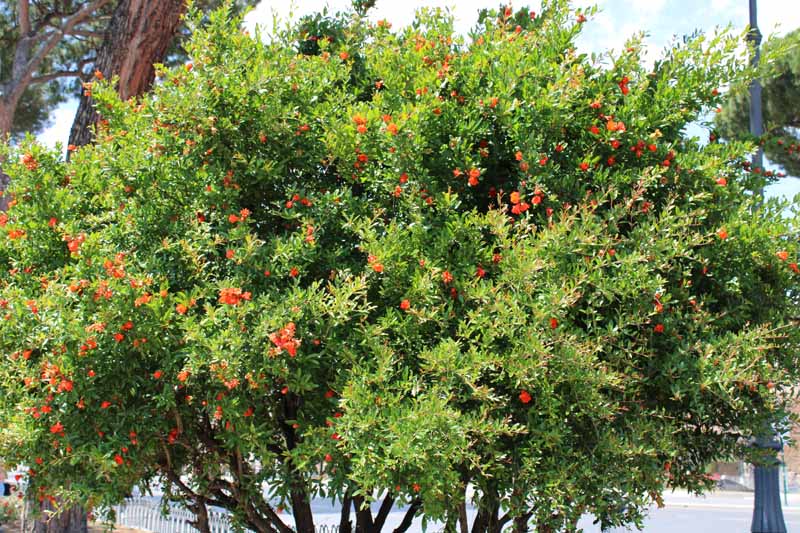
If you prefer to shape the plant into a tree form, you can choose three to five of the strongest vertical branches in the second year, and trim the rest out along with the smaller branches that are below the desired size and shape of the canopy.
We cover this in more detail in our guide to pruning pomegranates. (coming soon!)
Suckers should be pruned away each year, as they will drain energy from the plant with no benefit. These can also be propagated to start new plants, if you wish.
Plan to prune in late winter. Active growth takes place in early to mid-spring, and blooming occurs from spring through fall in most areas.
Throughout the blooming season, pomegranate trees will produce new blossoms in at least three cycles. The blooms are formed on the ends of the branches.
These blossoms can continue to set fruit throughout the season, but those that develop later will typically be smaller in size, and may not ripen fully prior to the end of fall, depending on your climate.
You’ll want to avoid pruning after the plant begins forming buds, as cutting these away will result in reduced fruit production.
In late winter, remove any damaged parts that have not survived the cold months, making way for fresh growth in the spring, as well as any crossing, downward-growing, or diseased branches.
This will also help to keep the size and shape of the tree or shrub manageable throughout the remainder of the year.
Keeping the plant trimmed for shape aids in ease of harvesting as well – otherwise, you’ll be wading into a thorn bush to gather fruit. It also opens up space in the canopy so light and air can penetrate, keeping the plant healthier and allowing fruits to ripen better.
It’s important to note that if you’re allowing the shrub to grow in its natural form, it may harbor excess humidity, and that can reduce blooming and lead to blossom drop.
Even without pruning for shape, you’ll still want to keep the plant open by pruning to allow for adequate airflow.

You may see other sources of information recommending summer pruning. While it is possible to prune in the summer, that’s also the time of year when your tree or shrub will be heavy with setting fruit.
This is not the ideal time to cut it back unless you have an important reason, such as serious damage from disease or infestation.
To maintain plant shape, plan to cut back no more than six to eight inches from the branches prior to the onset of budding, and no more than a third of the branches at a time.
Bear in mind that, with complete pollination, each blossom may result in a fruit that can weigh between one-quarter and three-quarters of a pound, depending on the variety.
Pomegranate trees are not known for being weight-bearing, and too many fruits per branch can lead to trouble, particularly in fragile young trees.
If you notice that the branches of the tree are so heavy that they’re drooping, pinch off some of the remaining blossoms, or even a few immature fruits, to reduce the strain before the branch cracks.
Fruit is also prone to cracking when rainfall and water availability fluctuate. There are other reasons why the fruit might split, and you can learn more about them in our guide.
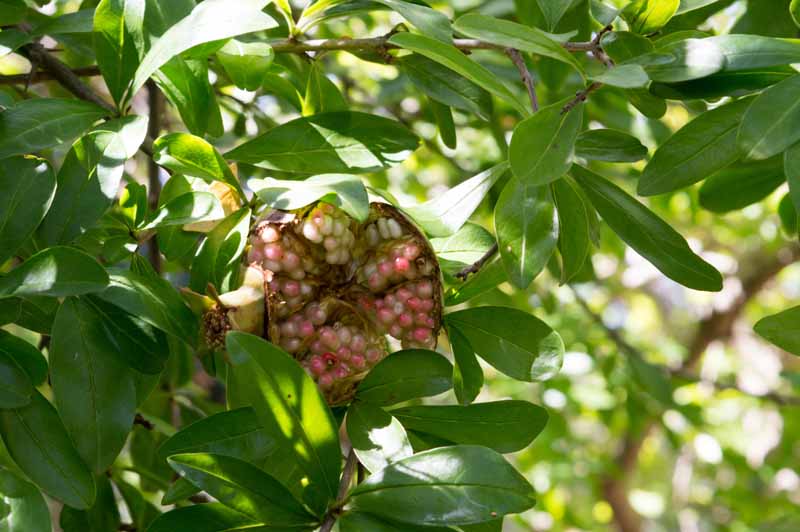
Any fruit that has not ripened completely before the end of the growing season should be pruned from the tree to prevent pests or disease from overwintering there, or being attracted to the tree.
Immature fruits can be composted as long as no signs of disease or pest damage are present, but you’ll want to cut them open to inspect the interior before introducing them to your compost pile.
If you prefer not to compost them or you see signs of damage, such as black or brown spots, mold, mildew, or visible pests, you can discard them in a well-sealed trash bag instead.
Fertilizer should be applied sparingly and only if you’ve noticed signs of nutrient deficiency. Learn more about fertilizing pomegranates in our guide.
Cultivars to Select
There is a long list of hundreds of named pomegranate cultivars in existence.
While some are better used for dye, or dried and ground to produce powdered spices used in dishes with rich flavor, such as those popular in Middle Eastern, Pakistani, and Indian cuisine, others are better known for their distinctive flavors or fruit color and form, such as purple or yellow varieties.
Purple Heart
This cultivar is also known as ‘Sharp Velvet.’ Fruits are large and red, with sweet arils and low acidity. They’re typically ready for harvest in October.
‘Purple Heart’ can grow up to 30 feet tall in ideal conditions. It’s well suited for use as a privacy hedge, or it may be trained to grow as an individual tree.
Plants are available in #1 containers from Nature Hills Nursery.
Red Silk
The ‘Red Silk’ variety is known for having a pericarp that is more pink than red, and a medium to large fruit size.
The arils offer a blend of sweetness and tartness, with a flavor that is reminiscent of red berries. Fruits are typically ready for harvest in September.
This dwarf cultivar has a shorter, smaller growth habit, reaching 18 feet at maturity. This makes it suitable for growing in smaller spaces, or in containers with pruning.
‘Red Silk’ plants are available in #1 containers from Nature Hills Nursery.
Wonderful
‘Wonderful’ is the variety most commonly sold in grocery stores. It reaches a mature height of 15 to 20 feet with a similar spread and is a prolific producer.
The large, deep red fruits reveal arils with a hard texture and a sweet-tart flavor and are ready to harvest in September to October.
You can find ‘Wonderful’ trees in one-gallon pots available from Yarden.
Want More Options?
If you’re looking for a longer list of options to consider for your home or garden, take a look at our roundup of fruiting varieties to grow at home.
Managing Pests and Disease
Pomegranates are less prone to pests and diseases than many types of fruit trees, provided they are planted in a suitable climate and given proper care.
The list of unwanted guests that you might see is short, and includes the likes of squirrels, aphids, leaf-footed bugs, and leafroller caterpillars.
Squirrels can be a real challenge to deal with, but most of the time, you can at least reduce the amount of fruit lost to them using methods such as wrapping developing fruit with barrier bags, and installing decoys of predatory animals to scare them off.
Insect pests can also be an annoyance in the case of minor infestations, though they may cause major crop losses when infestations are severe.
Diseases that affect pomegranates can be difficult to manage, such as cercospora fungus and heart rot.
Any time your plants show signs of illness or pest damage, such as leaf and bud drop, discoloration, or chewed fruit or leaves, it’s best to take quick action to assess the situation and develop a plan to prevent further damage.
We share more details about how to identify, prevent, and manage pest and disease issues in our comprehensive guide.
Harvesting Pomegranate Fruit
Aside from pruning, the toughest part of caring for a pomegranate tree or shrub is perhaps waiting for the harvest.
Depending upon the variety, the fruits can take anywhere from five to seven months to ripen and mature. Trees typically produce a harvestable crop starting two to five years after planting.

It can also be somewhat challenging to tell if the fruits are ripe, as they may not visibly change much throughout the last couple months of growth – unless you know what to look for.
Generally speaking, fruits that are set in March or April will be ready for harvest between August and October. Be sure to check the specifics for your selected cultivar and growing region.
You’ll notice three primary changes when the fruits are ripe for harvest: the shape of the pericarp, which will become more angular; the smoother texture and deeper color of the skin; and the heavier weight of the fruit.
Pull on a pair of heavy gloves and plan to harvest with great care to avoid being poked by sharp thorns. Don’t pull fruits off of the branches, as this method of harvest can cause damage.
Instead, use a set of sharp garden shears and snip the stems close to the fruit. Carefully place the fruit into your hod or another collection container of your choice to avoid bruising or scuffing.
While varieties grown commercially are better able to withstand a few pokes or bumps, other cultivars may prove to be more tender – even a long stem jabbing into its neighbor in the basket may cause minor damage.
For more detailed information, read our guide to harvesting pomegranates.
If you wish to use the flowers for tea making, plan to collect male blossoms that will not produce fruit, plucking them from the branches just after they open.
You can tell the difference between the two because the male blossoms are slightly smaller and shaped like a bell, whereas the perfect blossoms which produce fruit after pollination have a more bulbous shape at the base, which contains the ovary.
Leaves can be harvested at any time while they are still green and fresh on the tree.
Storing and Preserving
While they’re long-keepers, pomegranates need to be stored under proper conditions for best results. They’ll generally remain fresh for one to two weeks when kept at room temperature, out of direct sunlight.
Refrigeration is best for long storage, at a temperature between 32 and 40°F.
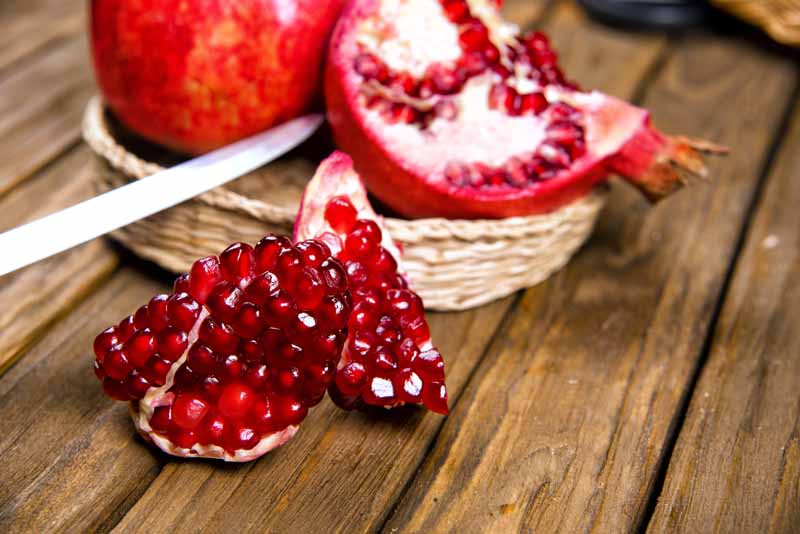
If they’re kept cool and dry, you can expect whole fruits to remain fresh for about two to three months. Wash them just before using.
You can also cut them open and remove the arils for storage so they’re ready to eat when you want them. You can store them fresh in the refrigerator for about five days.
Keep in mind that the juice can stain skin, clothes, and work surfaces, so you may want to use stainless steel utensils and bowls, and wear gloves if you have a lot of fruits to process.
To freeze, spread fresh arils out onto a cookie sheet covered in waxed paper and pop them into the freezer for about one to two hours. Transfer them to a freezer bag and freeze them for up to a year.
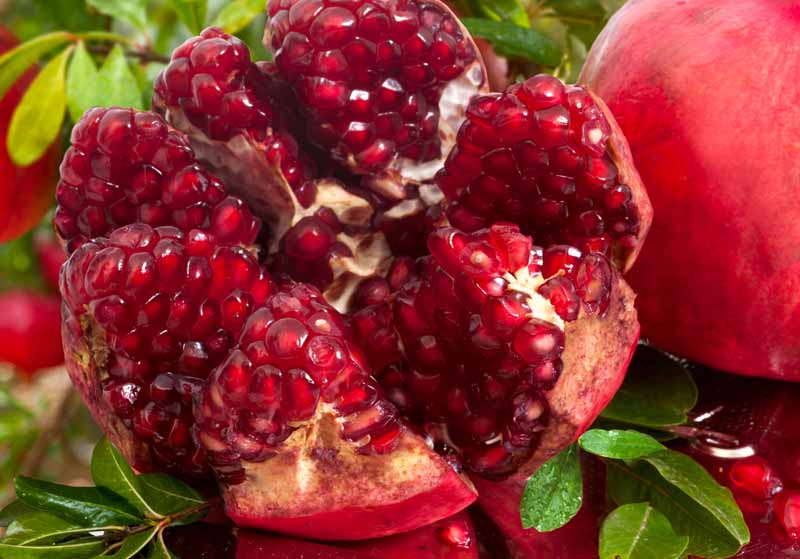
Arils can be processed to make juice, jam, jelly, or grenadine syrup, all of which can be used immediately or pressure canned for long-term storage. Fresh juice can be stored in the refrigerator for about a week.
Blossoms and leaves can be sun-dried or dehydrated and stored in an air-tight container, or used fresh to make tea.
Fresh blossoms and leaves that will not be dried or processed in some other way for storage should be used immediately.
We recommend an Excalibur dehydrator to extend the shelf life of your dehydrated foods, like this four-tray model, available via Amazon.

Excalibur Four-Tray Dehydrator
If you’re in the market for a good dehydrator, check out this guide to the best models from our sister site, Foodal.
A dried spice – known as anardana in Hindi, Punjabi, and Urdu, which is derived from the Persian anar, and known by many other names as well – is produced by dehydrating or sun-drying arils and crushing them into powder either by hand or with a food processor.
Dehydrated fruit that’s been processed into powder can be stored for several years in an airtight container. You can place it in the freezer, or store in a cool, dark, dry location such as a pantry.
Lumps are a sign that the powder has absorbed moisture, which can lead to spoilage.
Recipes and Cooking Ideas
First and foremost, you may need to know how to prepare a pomegranate for use in recipes or to eat the seeds alone. You can find information on preparing pomegranates on our sister site, Foodal.
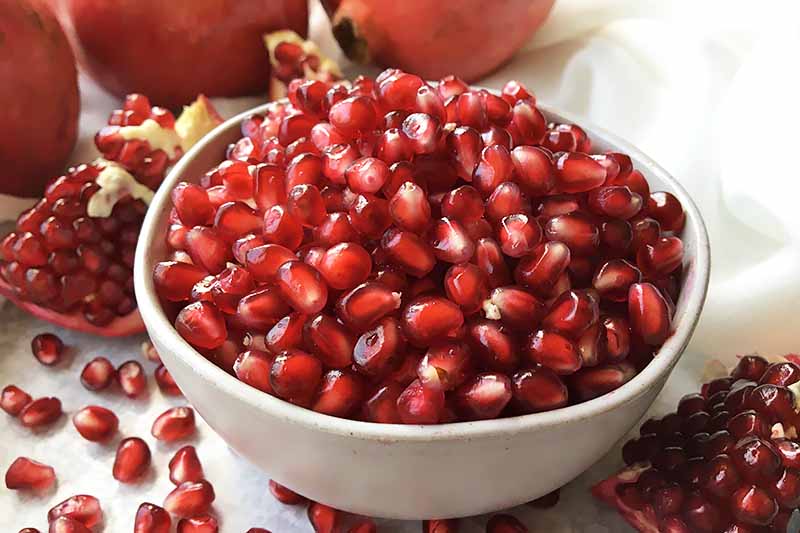
If you’re a fan of uniquely flavored beverages with a tart kick, you can blend pomegranates and blueberries in a fun and refreshing blueberry pomegranate chia fresca. Find the recipe for this tasty blend on Foodal as well.
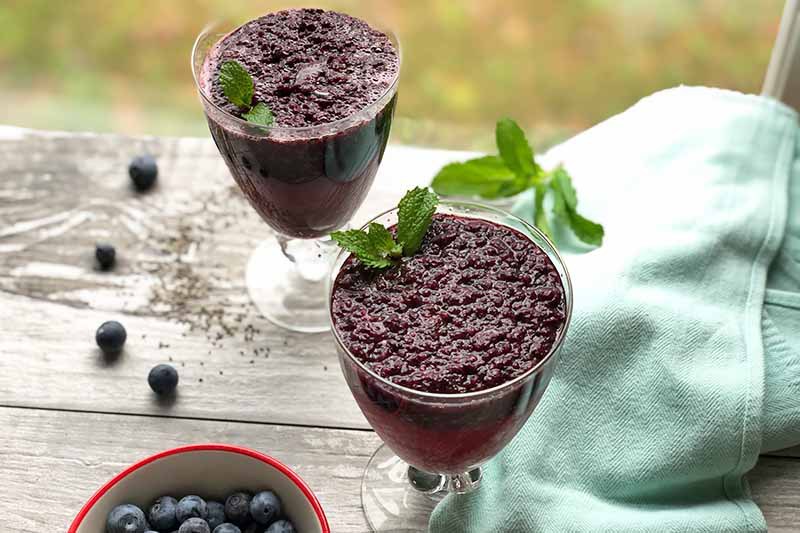
Since the fruits are harvested primarily in the fall, they make a perfect addition to the cranberry sauce that you might serve with seasonal holiday meals – or anytime! Get the recipe from Foodal here.
Whether sweet or savory, the fruit and the dried spice powder can be used in a variety of dishes, wherever you’re looking to add a punch of sweet-tart flavor. The arils also make a tasty garnish on salads, rice, and poultry dishes.
Young, tender leaves are best for fresh eating in salads and smoothies. Cooked, some growers like to use pomegranate leaves as an alternative to spinach.
Older, glossy leaves are more fibrous and these should always be cooked before eating.
Quick Reference Growing Guide
| Plant Type: | Deciduous fruiting shrub or tree | Water Needs: | Low to moderate |
| Native to: | Middle East | Maintenance: | Moderate |
| Hardiness (USDA Zone): | 7-11 | Tolerance: | Acid soil, drought |
| Season: | Fall | Soil Type: | Loam, sandy loam |
| Exposure: | Full sun | Soil pH: | 5.5-7.0 |
| Time to Maturity: | 3-5 years | Soil Drainage: | Well-draining |
| Spacing: | 10-20 feet | Companion Planting: | Basil, blackberries, blueberries, chamomile, celery, dill, elderberries, garlic, lavender, lemongrass, marigolds, mint, nasturtiums, parsley, raspberries, sage, strawberries, thyme |
| Planting Depth: | 1/2 inch (seeds), depth of root ball (transplants) | Order: | Myrtales |
| Height: | 15-20 feet | Family: | Lythraceae |
| Spread: | 15-20 feet | Genus: | Punica |
| Common Pests and Diseases: | Aphids, citrus flat mites, leaf-footed bugs, leafroller caterpillars, mealybugs, scale, squirrels, thrips; botrytis, cercospora leaf spot, heart rot, powdery mildew, root and collar rot | Species: | Granatum |
Plant a Bit of History for Delicious, Nutritious Fall Fruits!
When a fruit has survived the ages, being cultivated continuously from one generation to the next, you can bet it’s because of more than just flavor.
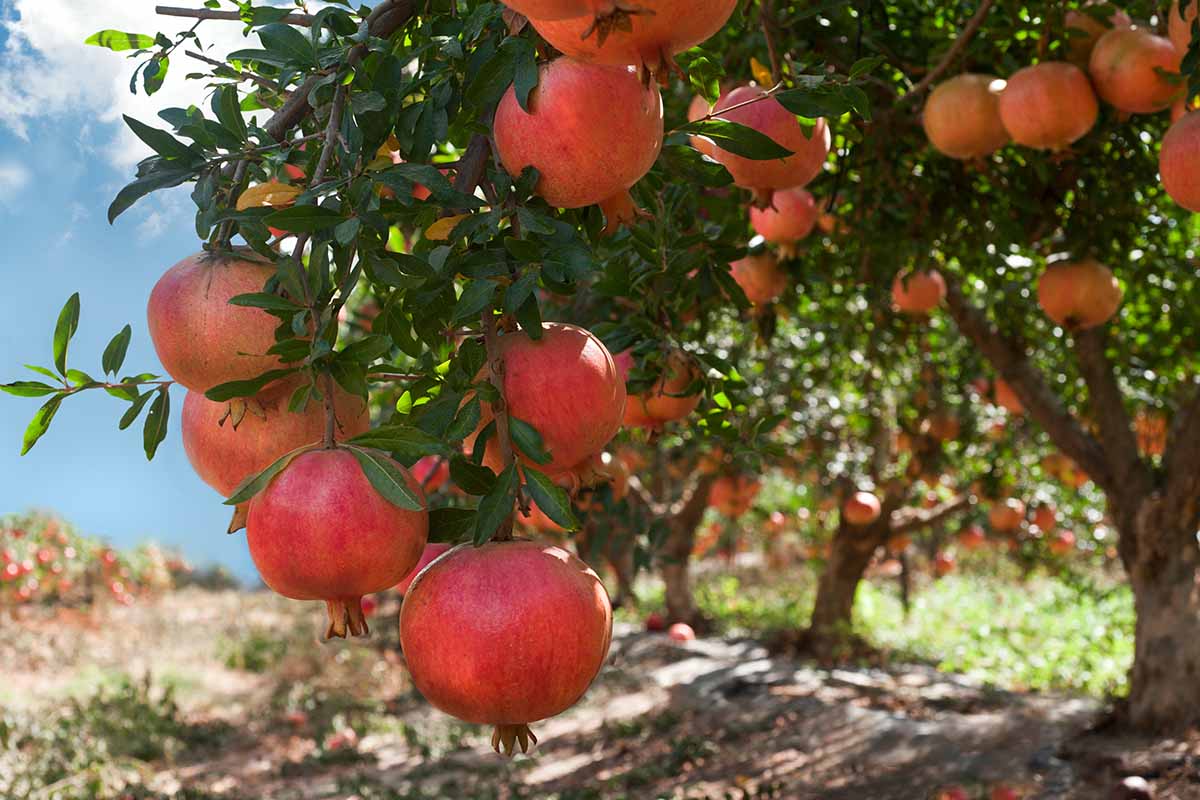
And indeed, in addition to its ornamental beauty and the ability to use it as a hedge or a tree in the garden, the pomegranate offers so many uses via its fruit, leaves, and flowers that you’ll have lots to explore.
If you’ve grown pomegranates before, we’d love to hear about some of your favorite recipes in the comments below! Share photos of your trees as well, if you’d like – we’d love to see them!
And for more information on growing fruit trees in your garden, have a read of these guides next:
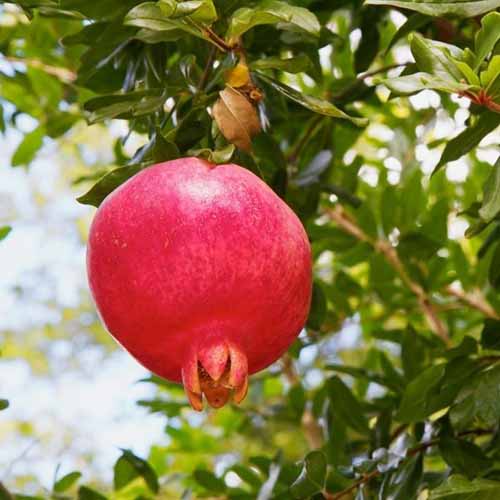

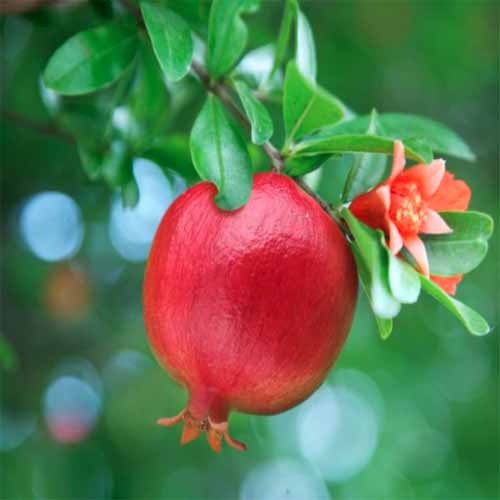
Very educating
Thank you, Hassan!
Loved the pomegranate article.
Glad you enjoyed it, James!
Thanks for the very interesting and informative article. I really love these wonderful trees; no pun intended; in my garden on a tiny island in the middle of the Mediterranean Sea called Malta!
Oh, Charles, I am truly jealous! Malta looks like a gorgeous place – I’ve always wanted to visit.
I’m so glad you found the article useful. If you have any pictures of your garden, some of us (ahem, ME!) would love to see them!
So much useful info, i’m fully prepared to look after my new pomegranate tree!
Thanks for reading, Mukul and I hope you enjoy your pomegranate tree. Be sure to let us know if you have any questions.
OH,KELLY!! Your writing about this wondrous and my most beloved fruit, tree, flower and everything about the Pomegranate, is simply as exquisite as this God-given tree itself!! As a young child on the farm in South Africa, I fell in love with the Pomegranate tree so deeply, it has been carried in my heart through all my many years! There is something in the Pomegranate that inspires awe and wonder in me, almost like something sacred, specially bestowed on humankind by God Himself- more so than any other of His amazing creations. From the greenest leaves, the incredible flamboyant flower… Read more »
Very informative article.
Thanks for reading Sandeep!